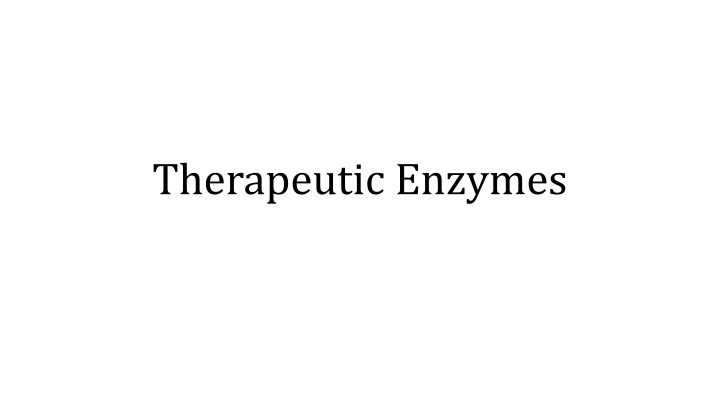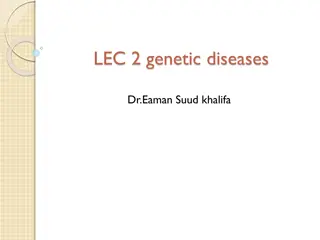
Therapeutic Enzymes for Cystic Fibrosis Treatment
Therapeutic enzymes, such as DNase I, are used to address the thick mucus buildup in the lungs of patients with cystic fibrosis. By hydrolyzing DNA chains, DNase I decreases mucus viscosity, making it easier for patients to breathe. While not a cure, this treatment has been FDA-approved and helps relieve the most severe symptom of the disease in many patients.
Download Presentation

Please find below an Image/Link to download the presentation.
The content on the website is provided AS IS for your information and personal use only. It may not be sold, licensed, or shared on other websites without obtaining consent from the author. If you encounter any issues during the download, it is possible that the publisher has removed the file from their server.
You are allowed to download the files provided on this website for personal or commercial use, subject to the condition that they are used lawfully. All files are the property of their respective owners.
The content on the website is provided AS IS for your information and personal use only. It may not be sold, licensed, or shared on other websites without obtaining consent from the author.
E N D
Presentation Transcript
Enzymes may be used therapeutically in a variety of ways. For example, they may be used to augment an existing metabolic pathway, thereby increasing the amount of a particular compound or metabolite that is a product of that pathway. Alternatively, some enzymes may be used to relieve the disease pressure caused by a pathogen or may help to lower the level of an overproduced metabolite.
DNase I Cystic fibrosis is one of the most common fatal hereditary diseases among Europeans and their descendants, with approximately 30,000 diagnosed cases in the United States and another 23,000 cases in Canada and Europe. It is estimated that a mutant cystic fibrosis gene is carried by 1 in 29 persons of European descent, 1 in 65 persons of African American descent, and 1 in 150 persons of Asian descent.
Individuals with cystic fibrosis are highly susceptible to bacterial infections in their lungs. Antibiotic treatment of patients who have these recurring infections eventually leads to the selection of antibiotic-resistant bacteria. The presence of bacteria, some alive and some lysed, contributes to the accumulation of a thick mucus in the lungs of these patients, making breathing very difficult and acting as a source for further infection.
The thick mucus in the lungs is the result of the combination of the alginate that is secreted by the living bacteria, the DNA that is released from lysed bacterial cells, and degenerating leukocytes that accumulate in response to the infection, as well as filamentous actin derived from the cytoskeleton of damaged epithelial cells To address this problem, scientists isolated the cDNA for the human enzyme deoxyribonuclease I (DNase I) and subsequently expressed the cDNA in CHO cells in culture. DNase I can hydrolyze long polymeric DNA chains into much shorter oligonucleotides.
The purified enzyme is delivered in an aerosol mist to the lungs of patients with cystic fibrosis. The DNase I decreases the viscosity and adhesivity of the mucus in the lungs and makes it easier for these patients to breathe. While this treatment is not a cure for cystic fibrosis, it nevertheless relieves the most severe symptom of the disease in most patients. In 1994, the FDA approved the enzyme for human use; it had sales of more than $250 million in 2008.
Alginate Lyase Alginate is a polysaccharide polymer that is produced by a wide range of seaweeds and both soil and marine bacteria. Alginate is composed of chains of the sugars -D-mannuronate and -L- guluronate. The properties of a particular alginate depend on the relative amounts and distribution of these two saccharides. For example, stretches of -l-guluronate residues form both interchain and intrachain cross-links by binding calcium ions, and the -d- mannuronate residues bind other metal ions.
The cross-linked alginate polymer forms an elastic gel. In general, the structure and size of an alginate polymer determine its viscosity. The excretion of alginate by mucoid strains of the bacterium Pseudomonas aeruginosa that infect the lungs of patients with cystic fibrosis significantly contributes to the viscosity of the mucus in the airways. Once mucoid strains of P. aeruginosa have become established in the lungs of cystic fibrosis patients, it is almost impossible to eliminate them by antibiotic treatment.
This is because the bacteria form biofilms in which the alginate prevents added antibiotics from coming into contact with the bacterial cells. In one experiment, it was shown that the addition of the enzyme alginate lyase, which can liquefy bacterial alginate, together with or prior to antibiotic treatment significantly decreased the number of bacteria found in biofilms
Thus, alginate lyase treatment not only decreases the viscosity of the mucus but also facilitates the ability of added antibiotics to kill the infecting bacterial cells. This result suggests that in addition to the DNase I treatment, depolymerization of the alginate might help clear blocked airways of individuals with cystic fibrosis. An alginate lyase gene has been isolated from a Flavobacterium species, a Gram-negative soil bacterium that is a strong producer of this enzyme.
A Flavobacterium genomic DNA library was constructed in E. coli and screened for alginate lyase-producing clones by plating the entire library onto solid medium containing alginate. Following growth, colonies that produced alginate lyase formed a halo around the colony when calcium was added to the plate. In the presence of calcium, all of the alginate in the medium, except in the immediate vicinity of an alginate lyase-positive clone, becomes cross-linked and opaque.
Since hydrolyzed alginate chains do not form cross-links, the medium surrounding an alginate lyase-positive clone is transparent. Analysis of a cloned DNA fragment from one of the positive colonies revealed an open reading frame encoding a polypeptide with a molecular mass of approximately 69,000 Da. Detailed biochemical and genetic studies indicated that this polypeptide is a precursor of the three different alginate lyases produced by the Flavobacterium sp.
After the 69,000-Da precursor is produced, a proteolytic enzyme cleaves off an N-terminal peptide of about 6,000 Da. The 63,000-Da protein can lyse both bacterial and seaweed alginates. Cleavage of the 63,000-Da protein yields a 23,000-Da enzyme that depolymerizes seaweed alginate and a 40,000-Da enzyme that is effective against bacterial alginate. To produce large amounts of the 40,000-Da enzyme, the DNA corresponding to the enzyme was subcloned and expressed in bacterial cells
When bacteria that express and secrete the 40,000-Da enzyme are grown in liquid medium, the recombinant alginate lyase efficiently liqueifies alginates produced by mucoid strains of P. aeruginosa isolated from the lungs of patients with cystic fibrosis. Unfortunately, since most sources of alginate lyase are nonhuman, these proteins are not necessarily a good choice for use as a therapeutic agent, as they are likely to generate an immune response in the patient, thereby causing a range of complications.
To significantly decrease the antigenicity of the alginate lyase, the enzyme may be chemically modified with polyethylene glycol (i.e., pegylation). However, nonspecific modification of alginate lyase with polyethylene glycol results in a large decrease in the activity of the enzyme. Nevertheless, it is possible to avoid the inactivation of the enzyme while still decreasing its antigenicity by specifically modifying alginate lyase with polyethylene glycol. To do this, several specific mutants of alginate lyase were created by directed mutagenesis in which one amino acid residue at a time was changed to cysteine
Then, the modified alginate lyases were each reacted with a modified form of polyethylene glycol that derivatized only the newly created cysteine residue. The modified (pegylated) enzymes were then tested for alginate lyase activity, antigenicity, and the ability to disrupt mucoid biofilms produced by the bacterium P. aeruginosa. One of the modified enzymes (in which an alanine residue at position 53 was changed to a cysteine residue) displayed behavior that was superior to those of both all of the other modified enzymes and the native enzyme.
Specifically, the selected modified enzyme degraded bacterial alginate 80% more rapidly than the native enzyme, disrupted 94% of an established P. aeruginosa biofilm (compared to 75% disruption of the biofilm by the native enzyme), and had reduced immunogenicity.



![Lec [2] Health promotion](/thumb/274962/lec-2-health-promotion-powerpoint-ppt-presentation.jpg)